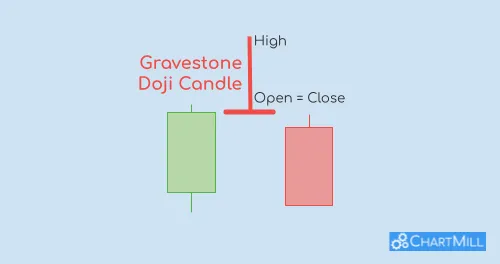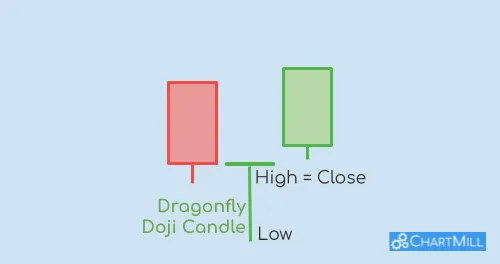Understanding the Gravestone Doji: A Bearish Reversal Warning Signal in Trading
By Kristoff De Turck - reviewed by Aldwin Keppens
~ 4 minutes read - Last update: Feb 20, 2025
In the world of technical analysis, candlestick patterns play a crucial role in helping traders identify potential trend reversals and market movements. One such pattern is the Gravestone Doji Candle.
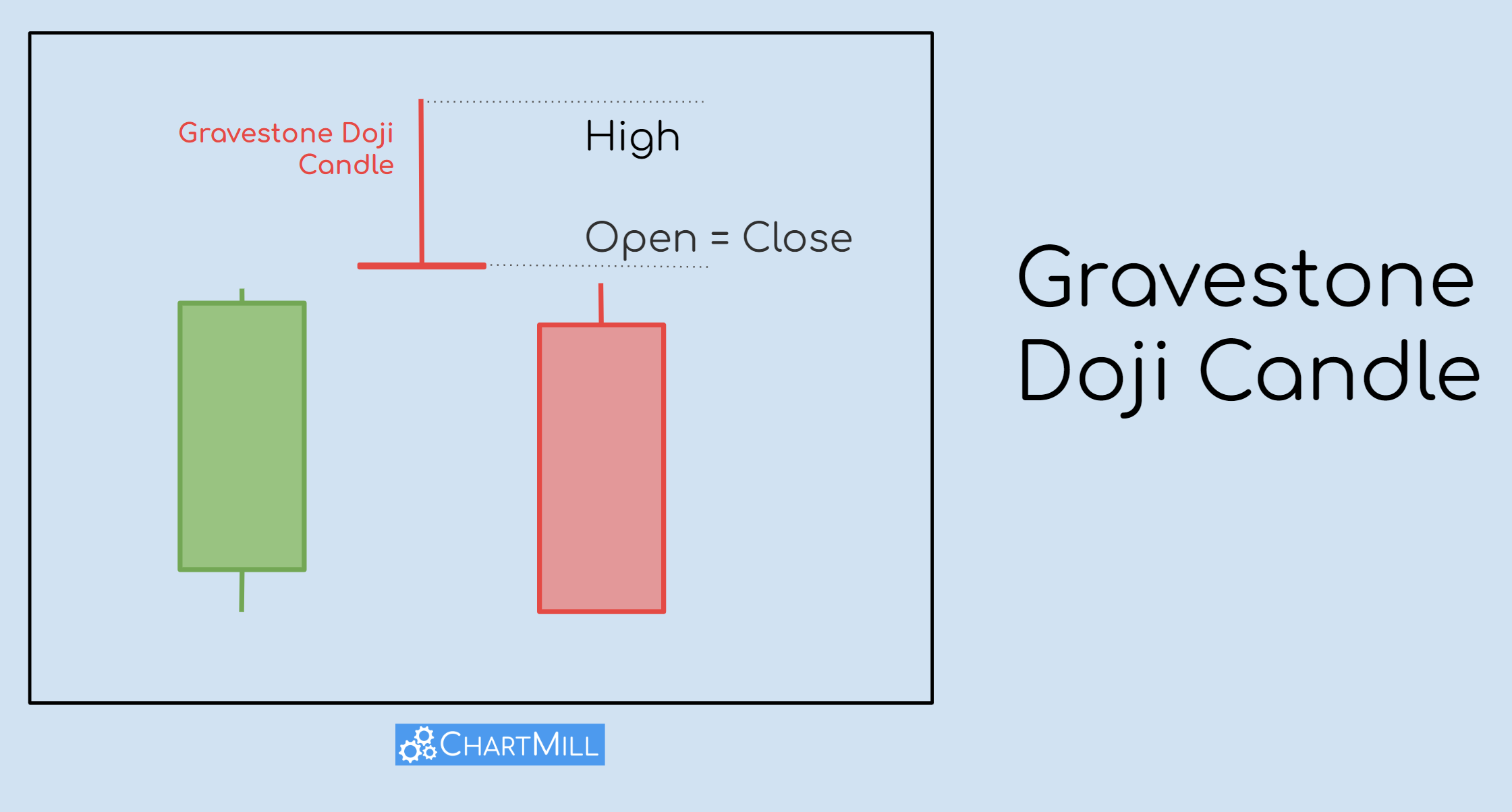
In this article, we will delve into the concept of this candlestick pattern, explore its meaning, discuss how it can be utilized in a trading strategy, and uncover the origins of its name.
What is a Gravestone Doji?
This candlestick pattern typically forms at the end of an uptrend, signaling a potential reversal in the market. Visually, it resembles a tombstone, with a long upper shadow and little to no lower shadow. The open, and close of the candle are nearly identical, indicating a state of market indecision.
The Bottom Line
-
The gravestone doji is a candlestick pattern that indicates market indecision and potential trend reversals.
-
It is characterized by a long upper shadow, little to no lower shadow, and open, close, and high prices that are nearly identical.
-
When it forms at the top of an uptrend, it suggests a potential reversal, signaling that buyers have lost momentum and sellers are gaining control.
The name derives from the visual resemblance of the candlestick pattern to a gravestone or tombstone. The long upper shadow represents the vertical structure of a tombstone, while the lack of a lower shadow signifies the absence of a solid foundation. The name effectively captures the bearish sentiment associated with this pattern.
What Does a Gravestone Doji Mean?
When this pattern appears on a price chart, it suggests that buyers have lost their momentum, and sellers are gaining control. This pattern signifies a shift in sentiment, where the market is rejecting higher prices and potentially heading toward a downward trend.
The long upper shadow of the gravestone doji represents the intraday high that was reached but rejected by the market participants. It highlights the failed attempt of buyers to sustain the bullish momentum.
On the other hand, the absence or minimal presence of a lower shadow indicates that sellers have successfully pushed the price down, closing near the low of the session.
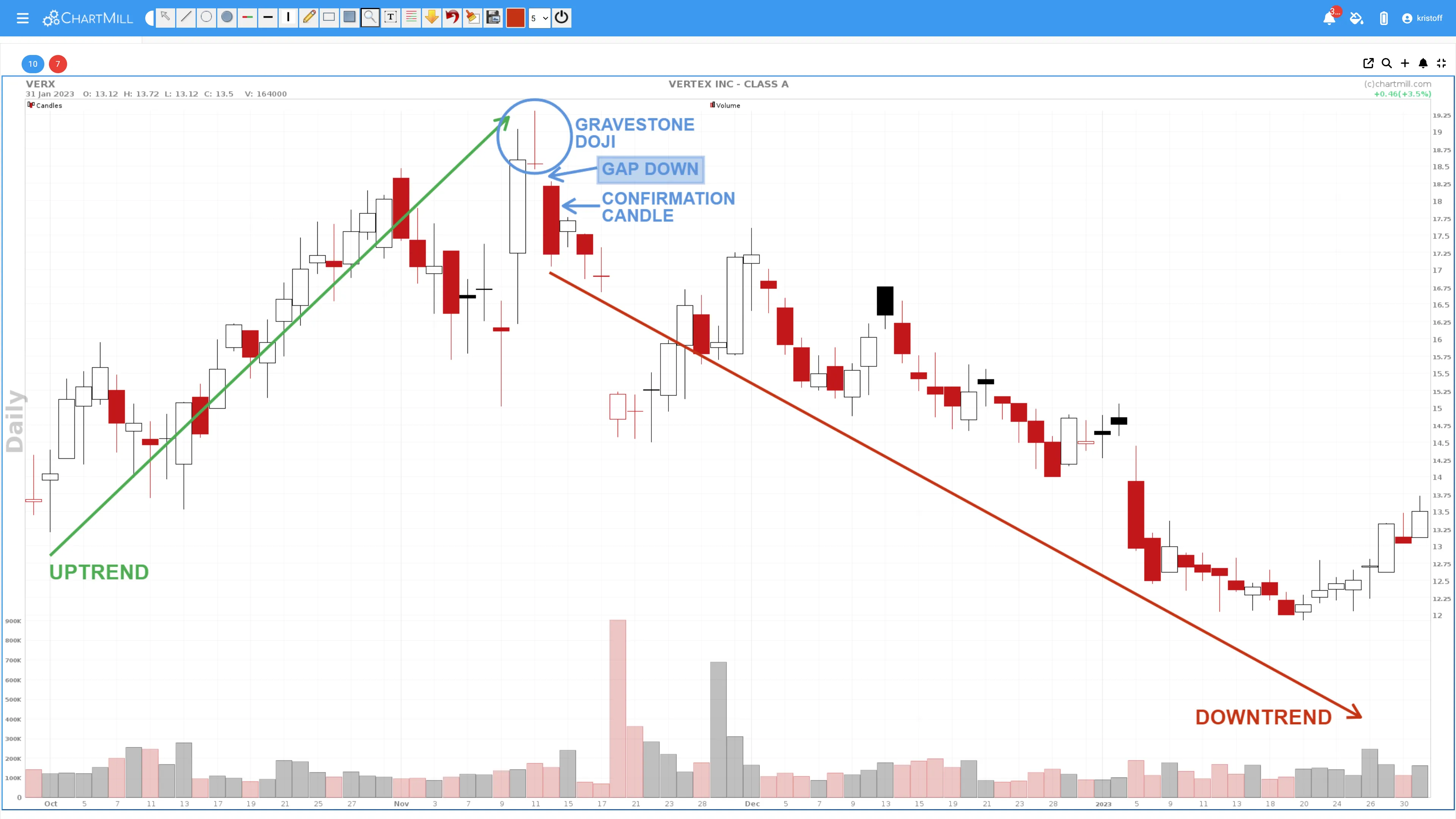
Does it matter where the gravestone doji occurs, at the bottom or the top of a price trend?
Yes, the placement of a gravestone doji within a price trend is significant and can influence its interpretation and potential implications. The location of it, whether at the top or bottom of a price trend, provides important contextual information for traders.
When a gravestone doji appears at the top of an uptrend, it carries more significance and suggests a higher probability of a trend reversal. This pattern indicates that buyers have lost their momentum and sellers are gaining control. The long upper shadow represents the market's failed attempt to sustain higher prices, showing that selling pressure has entered the market.
It can be a warning sign for traders to consider taking profits or opening short positions, anticipating a potential downtrend or market correction.
On the other hand, if a doji is formed at the bottom of a downtrend it is viewed by some traders as a bullish warning signal. The market uncertainty reflected by the candle remains the same. However, since the opening price was also the lowest price point and buyers have tried to push the price up during the trading session, it can be a sign of fledgling positive momentum.
How to Use the Gravestone Doji in a Trading Strategy?
The candlestick pattern can be a valuable tool in a trader's arsenal when used in conjunction with other technical indicators and analysis techniques. Here are a few ways to incorporate the gravestone doji into a trading strategy:
-
Reversal Signal: When a gravestone doji appears after a prolonged uptrend, it can serve as a signal for traders to consider taking profits or opening short positions. Confirmation from other indicators such as trendlines, support and resistance levels, or oscillators can increase the reliability of the signal.
-
Stop Loss Placement: Traders can use the high of the pattern as a potential stop loss level when selling short. Placing a stop loss above the gravestone doji's high helps manage risk by limiting potential losses if the market moves against the anticipated reversal.
-
Confirmation: While a single gravestone doji can be indicative of a potential reversal, confirmation from subsequent price action is essential. Traders often wait for additional bearish signals, such as a lower close in the following candles or a break below key support levels, before entering a trade.
An example of a trading setup based on the appearance of a gravestone doji candle after an uptrend.
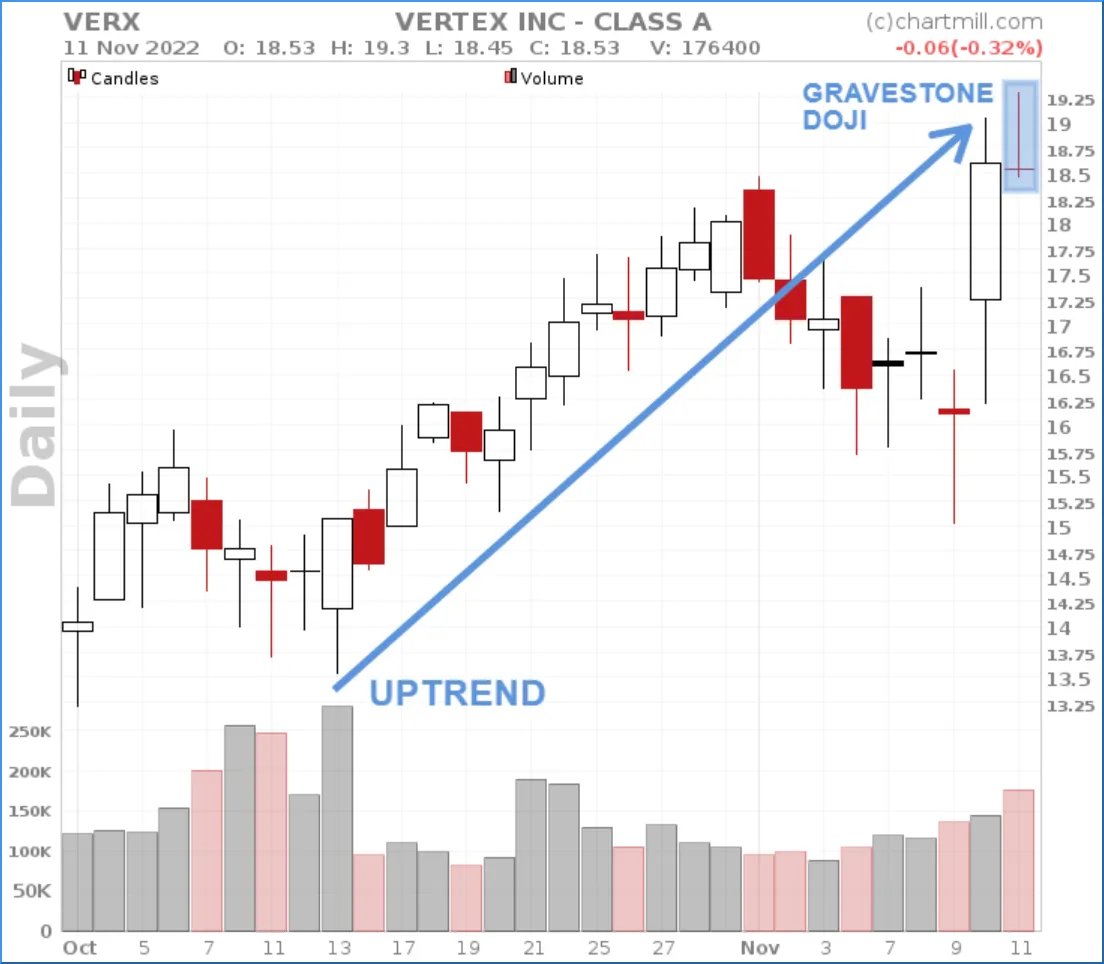
Step 1: recognizing a doji candle after an upward trend on the daily chart of Vertex Inc.
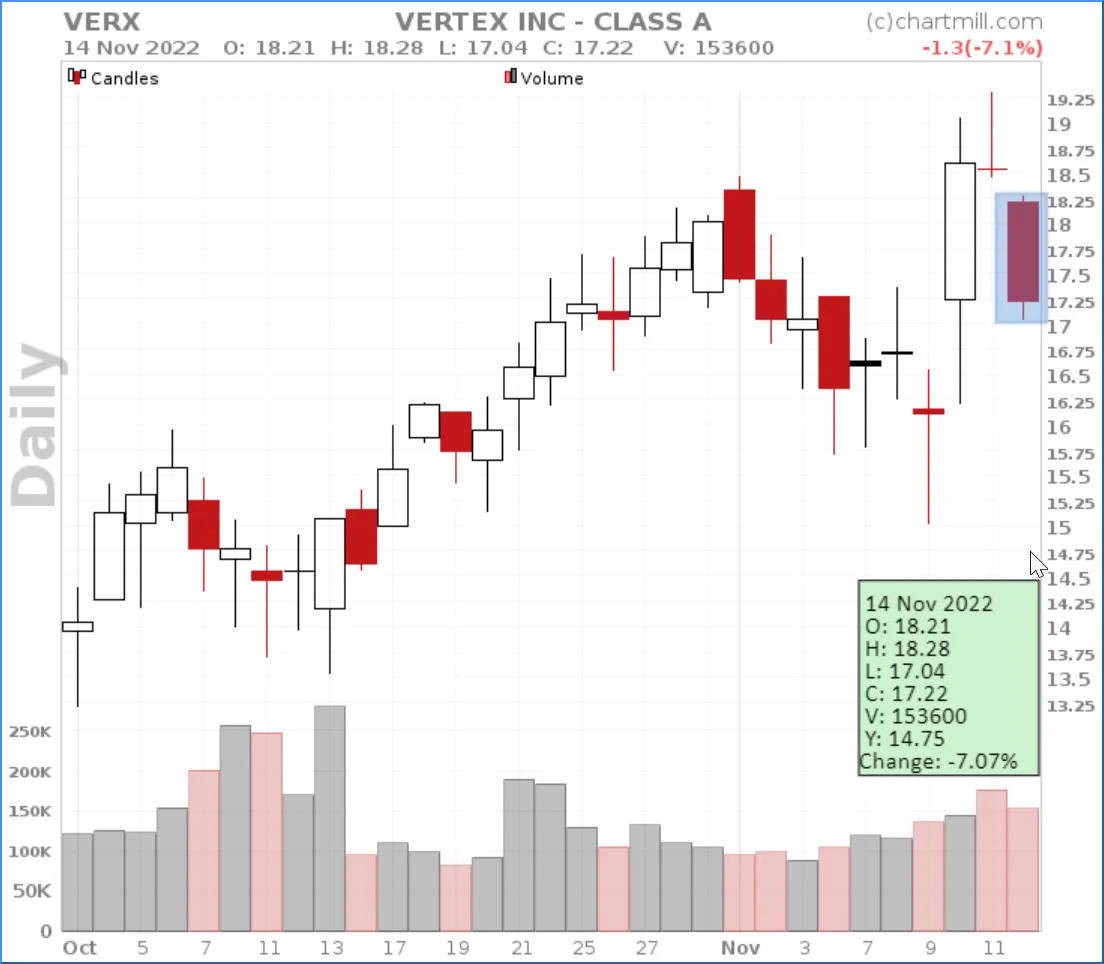
Step 2: The gravestone candlestick is not sufficiently reliable to use on its own. So wait for a confirmation signal as shown on this chart. The price opened with a gap down and a long red bearish candle formed with a close near the daily low.
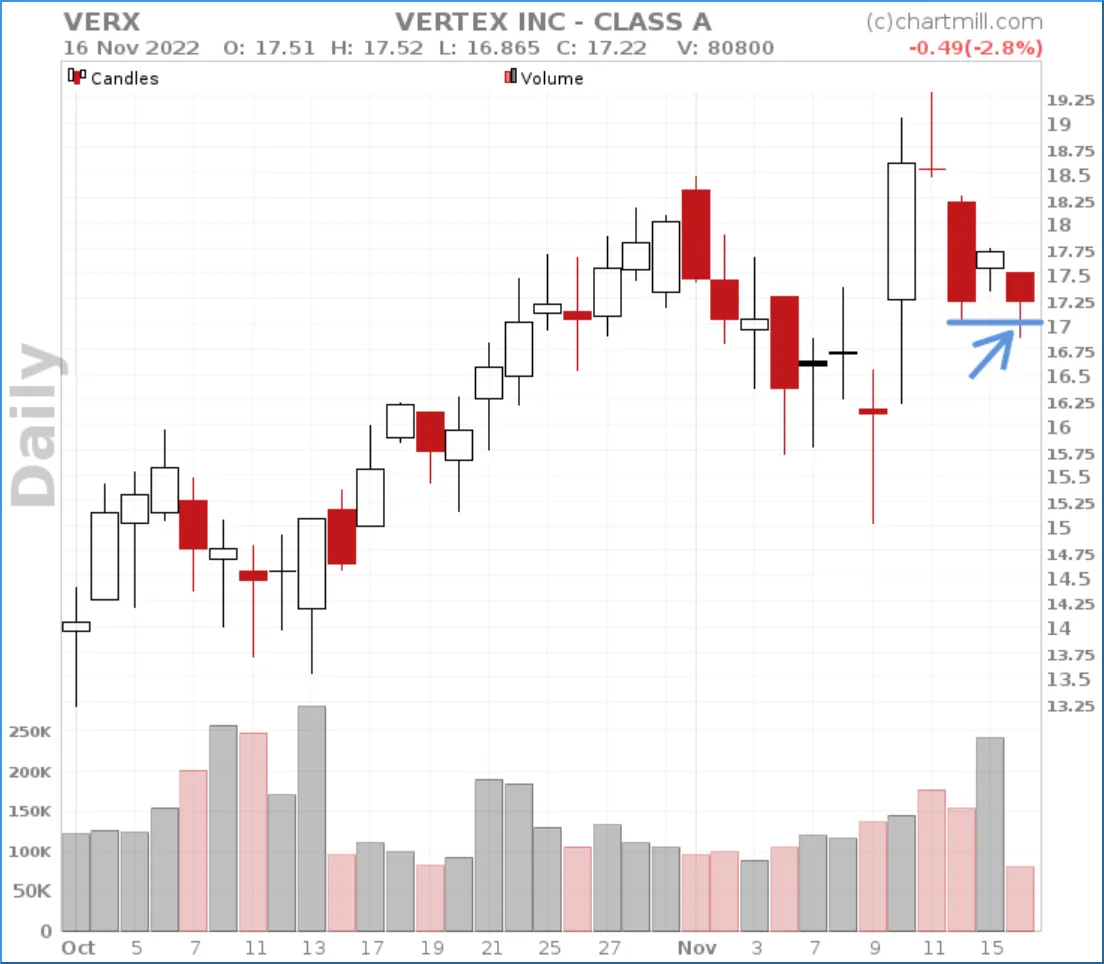
Step 3: instead of immediately taking a short position, wait until the price breaks through the low of the confirmation candle (blue horizontal line). This is an additional signal that momentum is down.
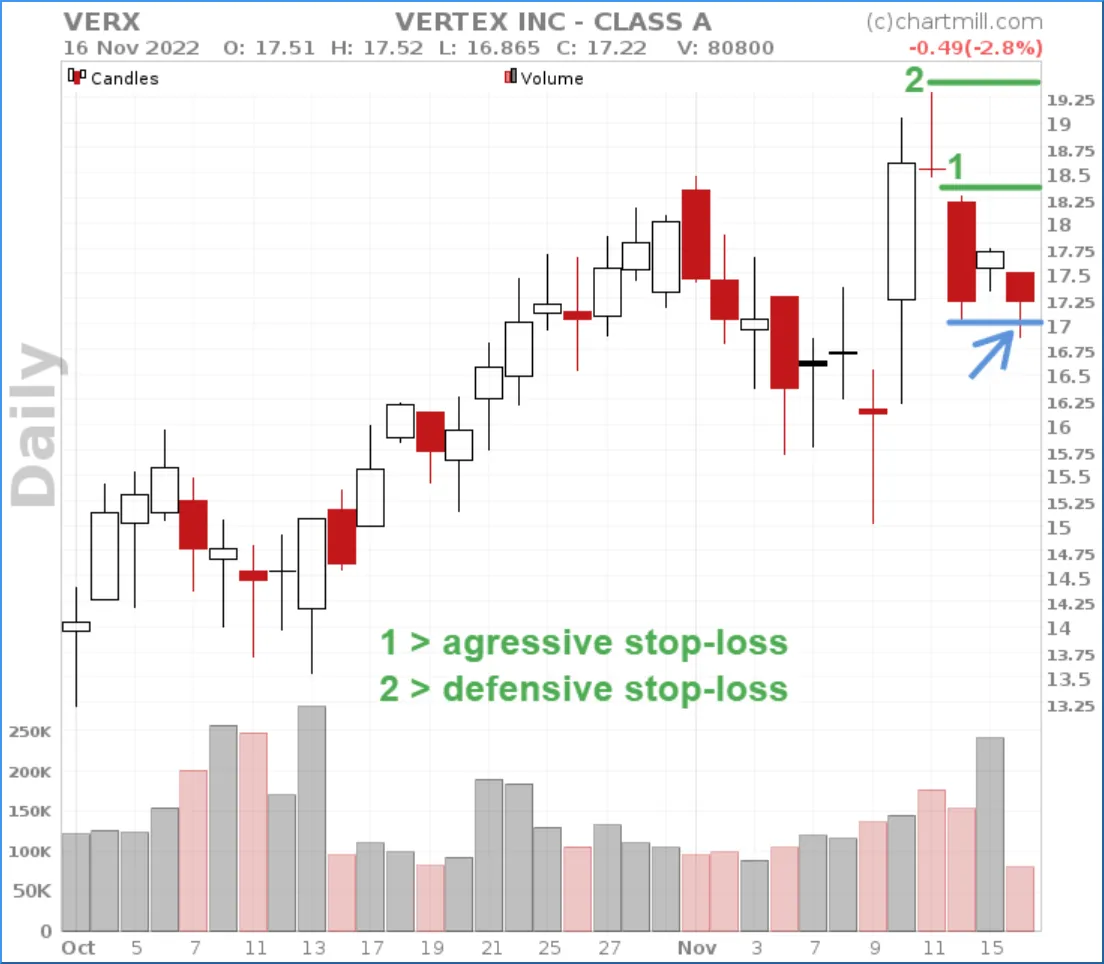
Step 4: Define your initial stoploss, either aggressively or more defensively.
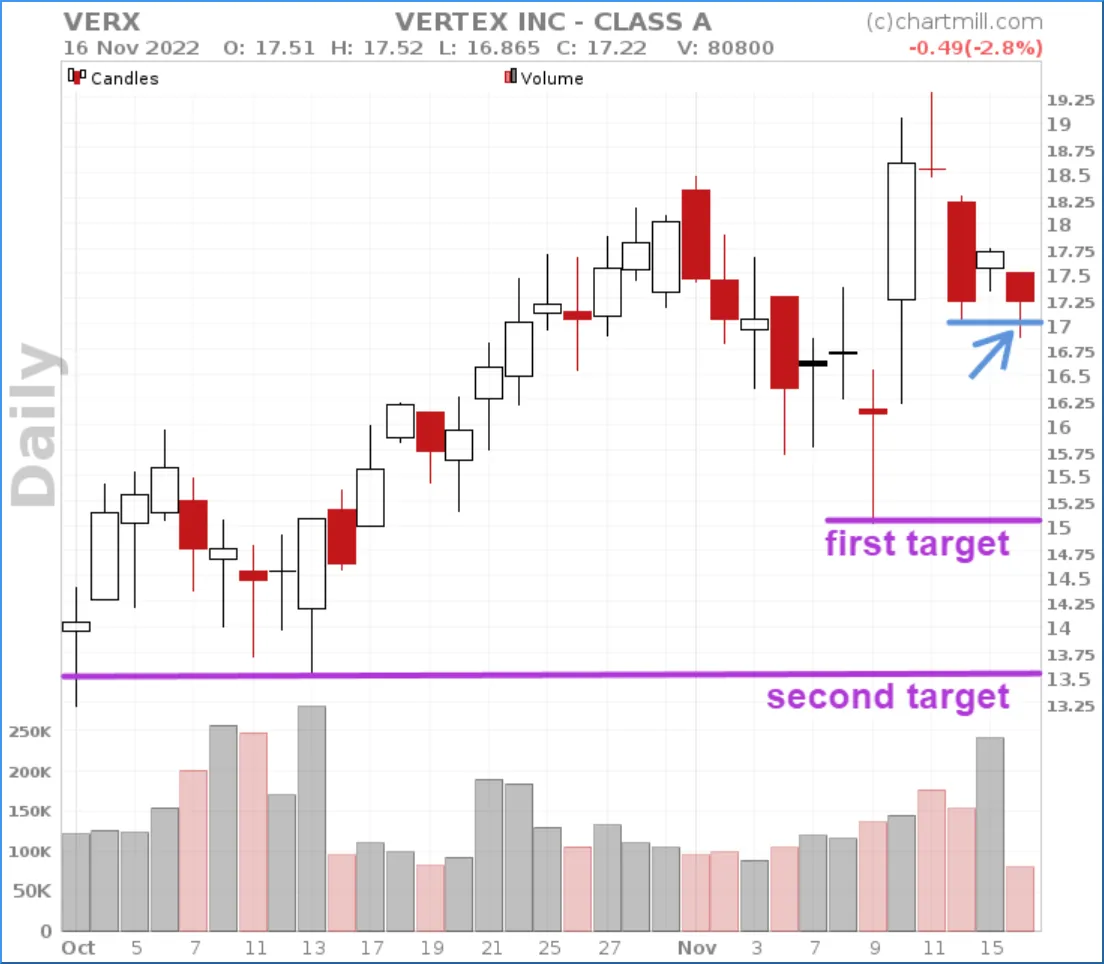
Step 5: Define your first (and second) target.
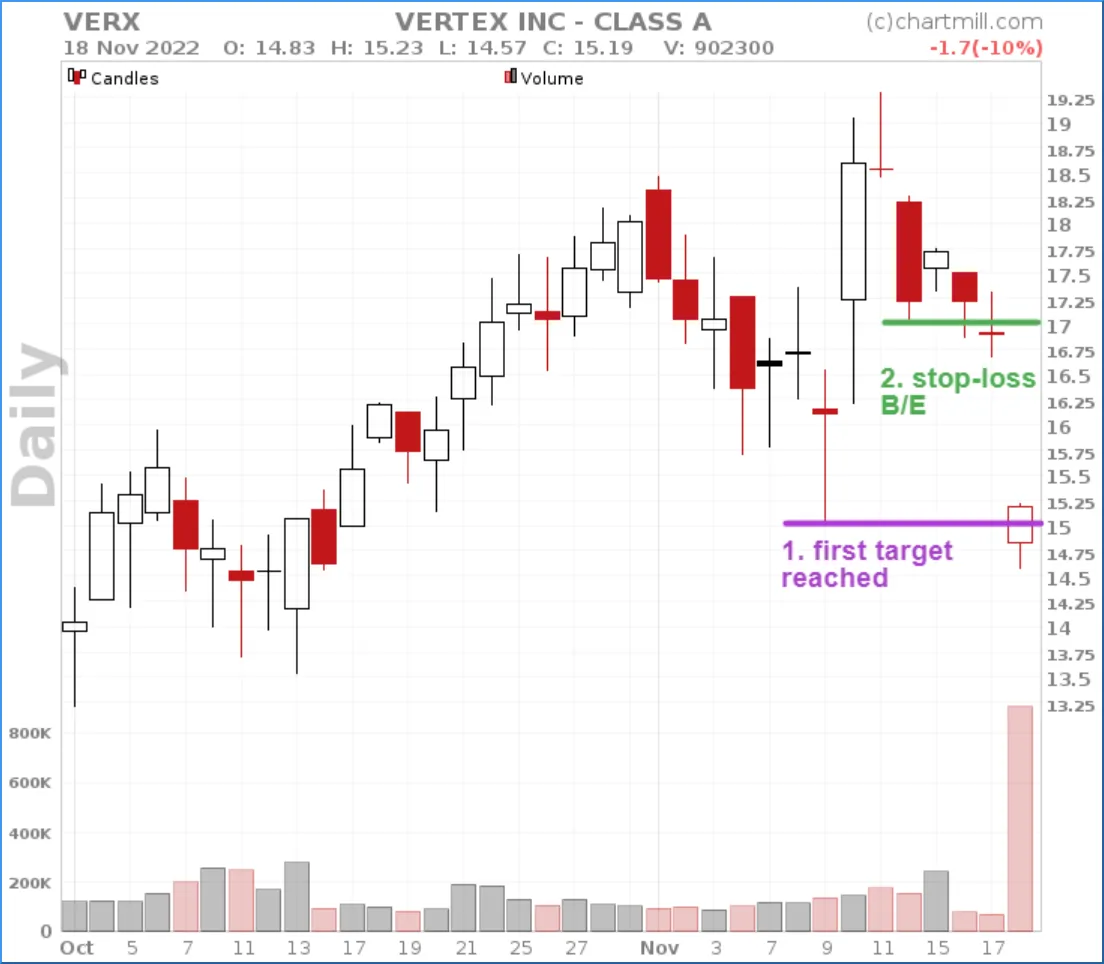
Step 6: first target was reached on Nov. 18. Several options are possible. If you do not close the position (completely) you can, for example, set the stop-loss at breakeven to eliminate the risk of loss.
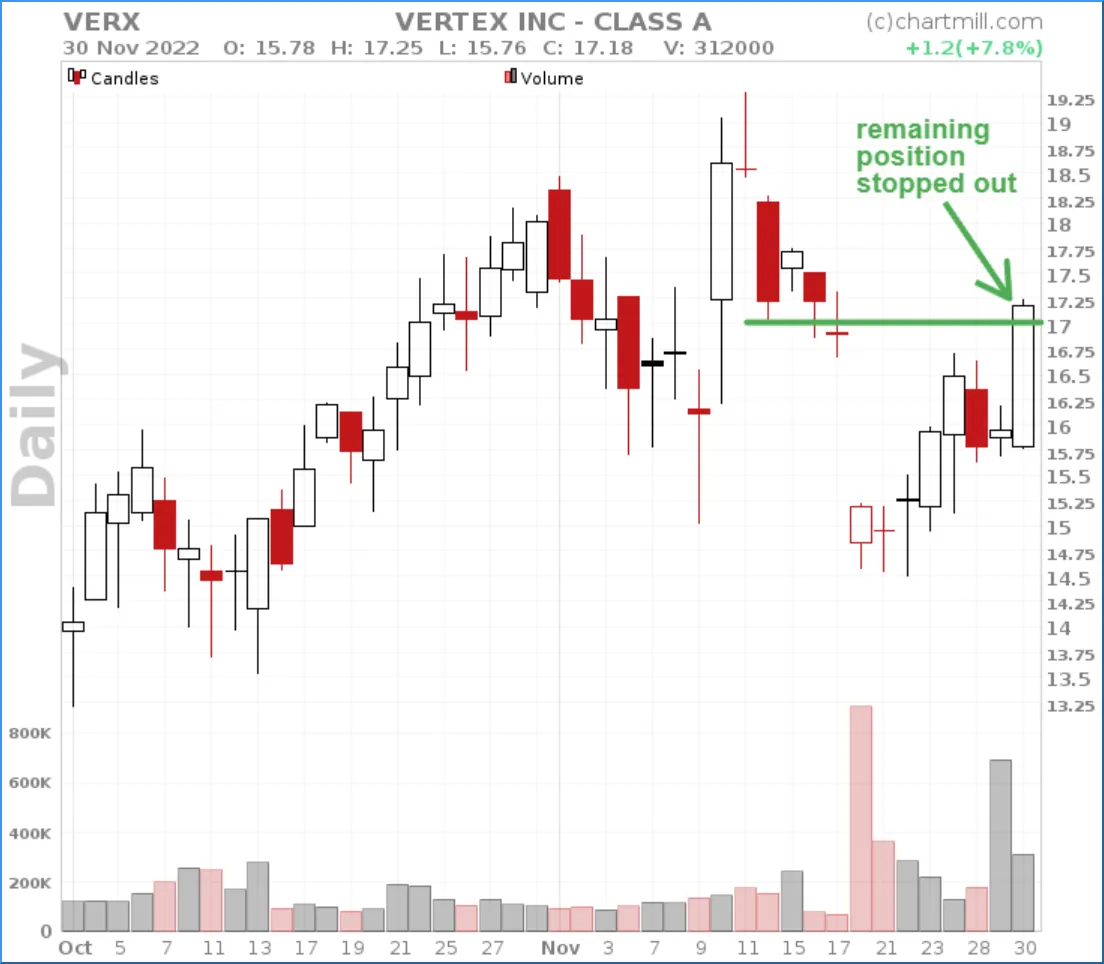
Step 6: remaining position was stopped out on november 30th.
Success Rate of the Gravestone Doji
The success rate of the Gravestone Doji depends on various factors, such as market conditions, timeframes, and additional confirmation signals.
Studies on candlestick patterns suggest that the Gravestone Doji alone has relatively low predictive accuracy. This is not uncommon among candlestick patterns.
What the Statistics Show - General Win Rate of the Gravestone Doji
Some backtests (such as those from Thomas Bulkowski’s Encyclopedia of Candlestick Charts) suggest that the Gravestone Doji has a success rate of around 50% when used on its own.
The pattern works best when combined with strong confirmation, such as a bearish follow-through candle or a rejection at a resistance level.
Additional Factors Affecting the Success Rate
Context Matters
When the pattern occurs at a key resistance level or after a strong uptrend, it is more likely to signal a reversal. However, if it appears in a sideways market without clear support or resistance levels, it has little significance.
Confirmation by the Next Candle
A strong red candle after the Doji (such as a bearish engulfing pattern) increases its reliability.
Volume Analysis
High volume on the Gravestone Doji increases the chances of a real reversal.
The Timeframe of the Candle
Higher timeframes (daily, weekly) tend to provide more reliable signals. Shorter timeframes (5-min, 15-min) often produce false signals due to market noise.
Gravestone Pattern Recognition in ChartMIll
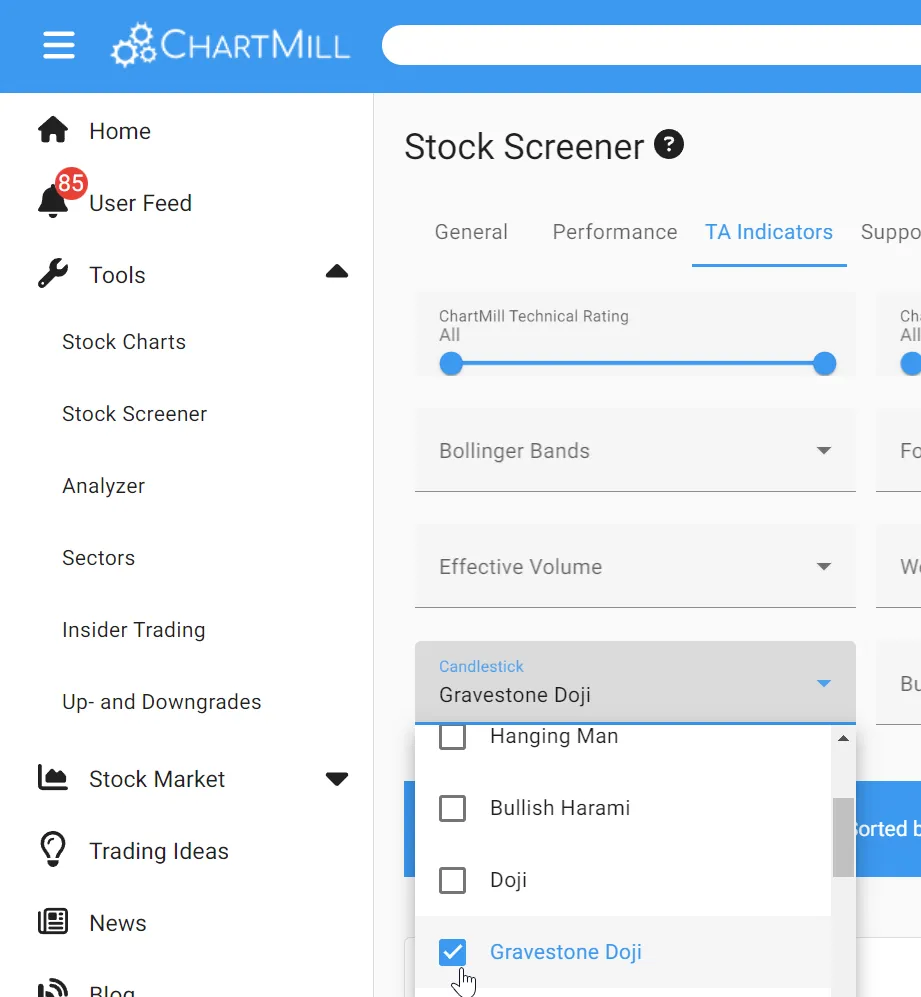
The gravestone pattern can be used as a screening filter in ChartMill. To do so, open the TA indicators menu on the stock screener page and open the drop-down menu under 'candlestick'. Then select the Gravestone Doji.
Conclusion
The gravestone doji candlestick pattern is a powerful tool for technical traders seeking to identify potential trend reversals and market downturns. Its appearance signifies a shift in market sentiment, where buyers lose control, and sellers gain momentum. By incorporating the this pattern into a comprehensive trading strategy, traders can enhance their decision-making process and improve their overall trading outcomes.
Remember to use it in conjunction with other technical analysis tools to confirm its validity and maximize its effectiveness.
More on Doji Candles...
The Dragonfly: a candlestick pattern to recognize new bullish trends in an early stage.
The dragonfly doji is a Japanese candlestick pattern consisting of only one candle. It is used to identify reversal patterns after a bearish price trend. More details
